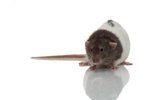If a black cat begins to turn gray, it could be something as innocent as the cat aging or it may require a veterinary visit as soon as possible. The shade of gray and the area of the body will tell you more about the problem at hand. Knowing your cat will help you decide what's going on.
Age
As black animals age, fur on their faces begins to turn white or gray. This change may also happen on the paws, chest or the stomach. White whiskers sometimes replace dark colored whiskers. Just like humans, cats lose pigment in their hair, as they enter their senior years.
Stress
Dark cats that have recently been through a very stressful situation, such as moving or a long stay at a veterinary office, can temporarily lose pigment in patches of fur. This results in a gray color that may or may not go away with time. Whether the gray color fades back to black usually has little to do with the cat's health or the cat's stress level.
Sickness
Cats that are sick, underfed or neglected can begin to lose pigment in their fur as their body labors to keep up. Gray fur that shows up due to an area being groomed too much, is wiry or more dirty than the rest of the cat, or is matted beyond reason can be the result of a sickness in the cat. Cats that have these symptoms must be taken to a veterinarian.
Injury
Injury that causes hair loss sometimes results in the hair growing back in a gray color on dark cats. Cats that have recently been spayed or undergone other types of surgery can have gray belly fur grow in to replace the shaved fur. Injuries or wounds that show the same problems as gray fur associated with sicknesses must be examined by a veterinarian.
Poor Grooming
Poor grooming, by the owner or the cat, can result in dandruff or mites that can cause fur to get a whitish film on it. This causes the fur to look gray, when it is in truth still black. Mange, flea infestations, and dust can all turn cats gray very quickly. If the cat begins to lose fur, it is time for a trip to the veterinarian for further review.
References





